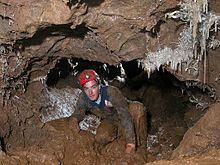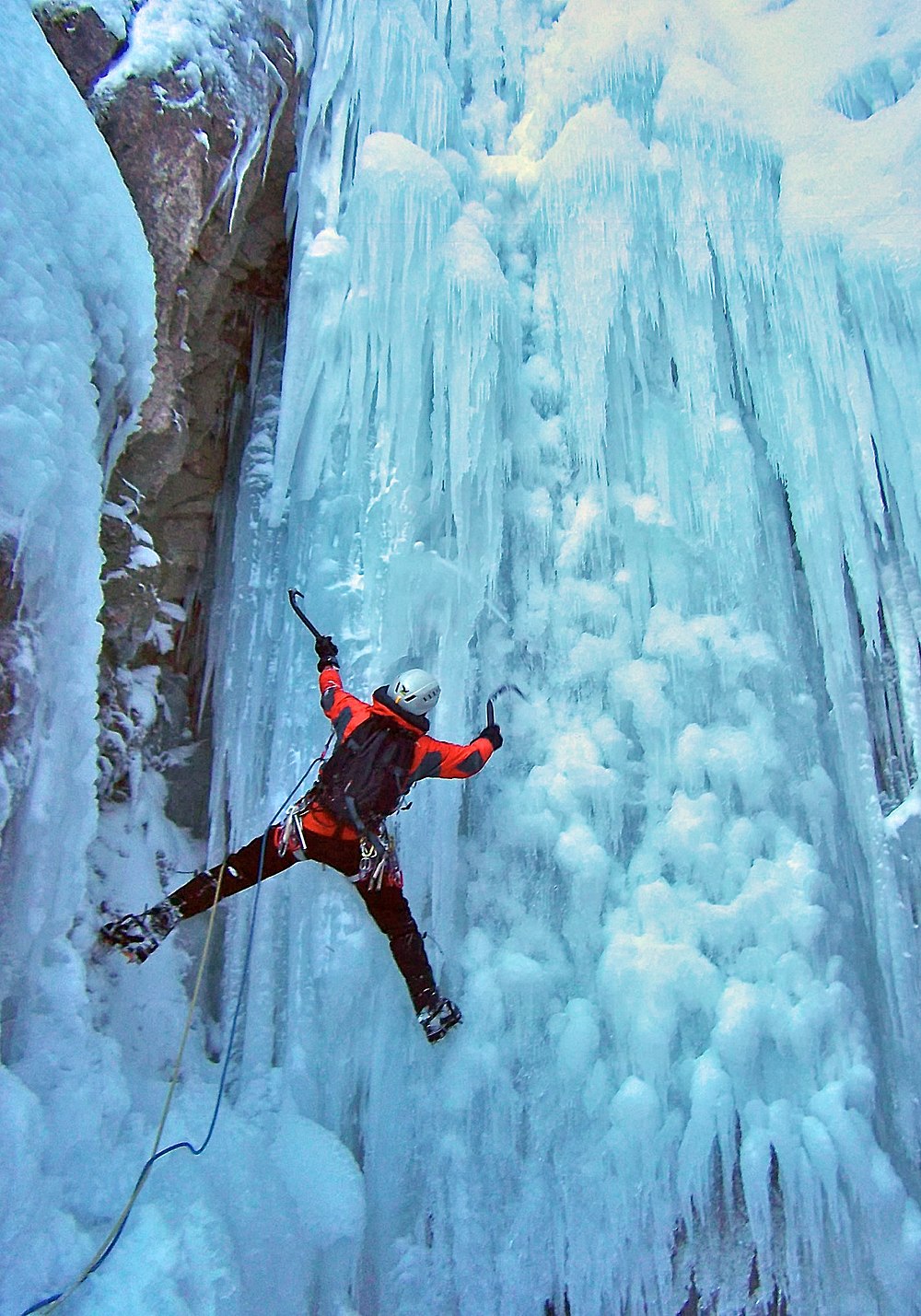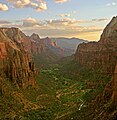Portal:Climbing
The Climbing Portal
Random climbing article
Some climbers' profiles have been increased by free soloing (e.g. Alex Honnold and John Bachar), but some question the ethics of this, and whether the risks they are undertaking should be encouraged and commercially rewarded. "Free solo" was originally a term of climber slang, but after the popularity of the Oscar-winning film Free Solo, Merriam-Webster officially added the word to their English dictionary in September 2019. (Full article...)

Because of the wide range and variety of rock formations around the world, rock climbing has been separated into several different styles and sub-disciplines, such as scrambling, bouldering, sport climbing, and trad (traditional) climbing.
Rock
Climbing sport disciplines
Lead Climbing
When lead climbing, the lead climber wears a harness tied to one end of a rope. The leader's partner provides the belay, paying out rope as needed, usually with the aid of a belay device, to catch the leader in the event of a fall. The lead climber ascends the route, periodically placing protection for safety in the event of a fall.
Competition climbing
- International Competitions: Sport climbing at the 2020 Summer Olympics • IFSC Climbing World Championships • IFSC Climbing World Cup • Sport climbing at the World Games • IFSC Climbing European Championships • IFSC Climbing Asian Cup • Rock Master
- Organizations: International Federation of Sport Climbing (IFSC) • International Climbing and Mountaineering Federation (UIAA) • USA Climbing • German Alpine Club (DAV) • British Mountaineering Council (BMC)
- Disciplines: Lead • Bouldering • Speed • Ice • Deep Water Solo

Unlike most sports, mountaineering lacks widely applied formal rules, regulations, and governance; mountaineers adhere to a large variety of techniques and philosophies (including
Selected Mountaineering Topics
- Rucksacks • Effects of high altitude on humans
- Timeline of climbing Mount Everest • Exploration of the High Alps
- Alpine clubs: Alpine Club (UK) • German Alpine Club (DAV) • Austrian Alpine Club • Swiss Alpine Club • Club Alpino Italiano (CAI) • American Alpine Club • Japanese Alpine Club
- Pioneers:
- High-altitude mountaineers: Other mountaineers
- Publicists: Karl Blodig • W. A. B. Coolidge • David Breashears • Jon Krakauer • Gaston Rébuffat
-
UIAA-certified twin ropes (from Rock-climbing equipment)
-
Sport/competition climbing quickdraw with a "bent-gate" at one end for easier clipping-in (from Rock-climbing equipment)
-
Sets of sewn webbing slings (from Rock-climbing equipment)
-
Various models of tubers, and a sticht plate (r-lower) (from Rock-climbing equipment)
-
Petzl's "via ferrata lanyard set" with attached "energy absorber" (from Rock-climbing equipment)
-
Climber using a bouldering mat (from Rock-climbing equipment)
-
A modern rock climbing shoe (from Rock-climbing equipment)
-
Non-locking (top) and locking (bottom) carabiners (from Rock-climbing equipment)
-
Rope (two on left) and cord (two on right) thicknesses compared (from Rock-climbing equipment)
-
Ascender attached to a rope (from Rock-climbing equipment)
-
Ahangboard (from Rock-climbing equipment)
- Hands: Chalk • Athletic taping
- Feet: Climbing shoe • Approach shoe • Mountaineering boot • Crampons • Ice cleat
- Rope: Dynamic rope • Static rope • Kernmantle rope
- Rope control: Sling
- Harness: Climbing harness
- Connectors: Carabiner • Quickdraw • Maillon
- Protection devices: Hex • Nut • Spring-loaded camming device • Tricam • Piton
- Permanent anchors: Anchor • Bolt
- Training: Campus board • Climbing hold • Climbing wall
- Ice: Ice tool • Ice axe • Ice screw
- Miscellaneous: Rock climbing hammer • Copperhead
Climbers
Random Selected Climber
Adam Ondra (born February 5, 1993) is a Czech professional rock climber, specializing in lead climbing, bouldering, and competition climbing. In 2013, Rock & Ice described Ondra as a prodigy and the leading climber of his generation. Ondra is the only male athlete to have won World Championship titles in both disciplines in the same year (2014) and is one of the two male athletes (alongside Sorato Anraku in 2023) to have won the World Cup series in both disciplines (lead climbing in 2009, 2015, and 2019 and bouldering in 2010).
At age 13, Ondra
Notable Climbers
- Competition climbers: Mina Markovic • Sean McColl • Akiyo Noguchi • Jakob Schubert • David Lama • Angela Eiter • Sandrine Levet • Tomáš Mrázek • Liv Sansoz • Kilian Fischhuber • Alexandre Chabot • François Petit
- Alex Megos • Sachi Amma • Stefano Ghisolfi • Ethan Pringle • Angela Eiter • Steve McClure • Sébastien Bouin • Julia Chanourdie
-
Blue Mountains, Australia (from Portal:Climbing/Popular climbing areas)
-
Lofoten, Norway (from Portal:Climbing/Popular climbing areas)
-
Avers Valley / Magic Wood, Switzerland (from Portal:Climbing/Popular climbing areas)
-
Black Canyon of the Gunnison National Park, United States (from Portal:Climbing/Popular climbing areas)
-
Vercors Massif, France (from Portal:Climbing/Popular climbing areas)
-
Ötztal Alps, Austria (from Portal:Climbing/Popular climbing areas)
-
Devils Tower, United States (from Portal:Climbing/Popular climbing areas)
-
Belogradchik, Bulgaria (from Portal:Climbing/Popular climbing areas)
-
Kalymnos, Greece (from Portal:Climbing/Popular climbing areas)
-
Zion National Park, United States (from Portal:Climbing/Popular climbing areas)
-
Buoux, France (from Portal:Climbing/Popular climbing areas)
-
Ore Mountains, Germany (from Portal:Climbing/Popular climbing areas)
-
Verdon Gorge, France (from Portal:Climbing/Popular climbing areas)
-
Arco, Italy (from Portal:Climbing/Popular climbing areas)
-
Joshua Tree National Park, United States (from Portal:Climbing/Popular climbing areas)
-
Yosemite National Park, United States (from Portal:Climbing/Popular climbing areas)
-
Harz, Germany (from Portal:Climbing/Popular climbing areas)
-
Bohemian-Moravian Highlands, Czech Republic (from Portal:Climbing/Popular climbing areas)
-
Calanque, France (from Portal:Climbing/Popular climbing areas)
-
Flatanger, Norway (from Portal:Climbing/Popular climbing areas)
-
City of Rocks National Reserve, United States (from Portal:Climbing/Popular climbing areas)
-
Ardèche, France (from Portal:Climbing/Popular climbing areas)
-
Peak District, United Kingdom (from Portal:Climbing/Popular climbing areas)
-
Lake District, United Kingdom (from Portal:Climbing/Popular climbing areas)
-
Gorges du Loup, France (from Portal:Climbing/Popular climbing areas)
-
Rodellar, Spain (from Portal:Climbing/Popular climbing areas)
-
Leonidio, Greece (from Portal:Climbing/Popular climbing areas)
-
Canmore, Canada (from Portal:Climbing/Popular climbing areas)
-
Krabi, Thailand (from Portal:Climbing/Popular climbing areas)
-
Mount Kaputar National Park, Australia (from Portal:Climbing/Popular climbing areas)
-
Lusatian Mountains, Czech Republic (from Portal:Climbing/Popular climbing areas)
-
Finale Ligure, Italy (from Portal:Climbing/Popular climbing areas)
-
Peshastin Pinnacles State Park, United States (from Portal:Climbing/Popular climbing areas)
-
Costa Blanca, Spain (from Portal:Climbing/Popular climbing areas)
-
Fontainebleau, France (from Portal:Climbing/Popular climbing areas)
-
Kaiser Mountains, Austria (from Portal:Climbing/Popular climbing areas)
-
Tisá, Czech Republic (from Portal:Climbing/Popular climbing areas)
-
Owens River Gorge, United States (from Portal:Climbing/Popular climbing areas)
-
Sella, Spain (from Portal:Climbing/Popular climbing areas)
-
Magaliesberg, South Africa (from Portal:Climbing/Popular climbing areas)
-
Siurana, Spain (from Portal:Climbing/Popular climbing areas)
-
Mallorca, Spain (from Portal:Climbing/Popular climbing areas)
-
Zittau Mountains, Germany (from Portal:Climbing/Popular climbing areas)
-
Red River Gorge, United States (from Portal:Climbing/Popular climbing areas)
-
Arches National Park, United States (from Portal:Climbing/Popular climbing areas)
-
Alpstein, Switzerland (from Portal:Climbing/Popular climbing areas)
-
Bohemian Paradise, Czech Republic (from Portal:Climbing/Popular climbing areas)
-
El Chorro, Spain (from Portal:Climbing/Popular climbing areas)
-
Acadia National Park, United States (from Portal:Climbing/Popular climbing areas)
-
Cederberg, South Africa (from Portal:Climbing/Popular climbing areas)
-
Saxon Switzerland, Germany (from Portal:Climbing/Popular climbing areas)
-
Shawangunk Ridge, United States (from Portal:Climbing/Popular climbing areas)
-
Isle of Portland, United Kingdom (from Portal:Climbing/Popular climbing areas)
-
La Huasteca, Mexico (from Portal:Climbing/Popular climbing areas)
-
Franconian Switzerland, Germany (from Portal:Climbing/Popular climbing areas)
Climbing area
Glossary of climbing terms relates to rock climbing (including aid climbing, lead climbing, bouldering, and competition climbing), mountaineering, and to ice climbing. (Full article...)
Tree climbing is a recreational or functional activity consisting of ascending and moving around in the crowns of trees.
A rope, helmet, and harness can be used to increase the safety of the climber. Other equipment can also be used, depending on the experience and skill of the tree climber. Some tree climbers take special hammocks called "Treeboats" and Portaledges with them into canopies where they can have a picnic or sleep.
Some tree climbers employ a mixture of techniques and gear derived from rock climbing and caving. These techniques are also used to climb trees for other purposes: tree care (arborists), animal rescue, research, and activism. (Full article...)

Although non-technical descents such as
Canyoning is frequently done in remote and rugged settings and often requires navigational, route-finding, and other wilderness travel skills. (Full article...)

is the scientific study of caves and the cave environment.
The challenges involved in caving vary according to the cave being visited; in addition to the total absence of light beyond the entrance, negotiating
Sometimes categorized as an "extreme sport", it is not commonly considered as such by longtime enthusiasts, who may dislike the term for its connotation of disregard for safety. (Full article...)
Categories
Related Portals
Associated Wikimedia
The following Wikimedia Foundation sister projects provide more on this subject:
-
Commons
Free media repository -
Wikibooks
Free textbooks and manuals -
Wikidata
Free knowledge base -
Wikinews
Free-content news -
Wikiquote
Collection of quotations -
Wikisource
Free-content library -
Wikiversity
Free learning tools -
Wiktionary
Dictionary and thesaurus


































































































